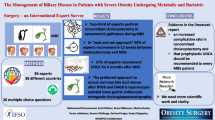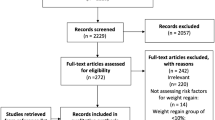Abstract
Background
Obesity has been reported to adversely affect the outcome of laparoscopic antireflux surgery (LARS). This study examined pre- and postoperative clinical and objective outcomes and quality of life in obese and normal-weight patients following LARS at a specialized centre.
Methods
Prospective data from patients subjected to LARS (Nissen or Toupet fundoplication) for symptomatic gastroesophageal reflux disease in the General Public Hospital of Zell am See were analyzed. Patients were divided in two groups: normal weight [body mass index (BMI) 20–25 kg/m2] and obese (BMI ≥30 kg/m2). Gastrointestinal quality of life index (GIQLI), symptom grading, esophageal manometry and multichannel intraluminal impedance monitoring data were documented and compared preoperatively and at 1 year postoperatively.
Result
The study cohort included forty normal-weight and forty obese patients. Mean follow-up was 14.7 ± 2.4 months. The mean GIQLI improved significantly after surgery in both groups (p < 0.001, for both). Clinical outcomes improved following surgery regardless of BMI. There were significant improvements of typical and atypical reflux symptoms in normal weight and obese (p = 0.007; p = 0.006, respectively), but no difference in gas bloat and bowel dysfunction symptoms could be found. No intra- or perioperative complications occurred. A total of six patients had to be reoperated (7.5 %), two (5 %) in the obese group and four (10 %) in the normal-weight group, because of recurrent hiatal hernia and slipping of the wrap or persistent dysphagia due to closure of the wrap.
Conclusion
Obesity is not associated with a poorer clinical and objective outcome after LARS. Increased BMI seems not to be a risk factor for recurrent symptomatology and reoperation.
Similar content being viewed by others
References
WHO Expert Committee (2000) Obesity:preventing and managing the global epidemic. Report of a WHO consultation. World Health Organization Tech Rep Ser 894(I–xiii):1–253
Corley DA, Kubo A (2006) Body mass index and gastroesophageal reflux disease: a systematic review and meta-analysis. Am J Gastroenterol 101(11):2619–2628
Hampel H, Abraham NS, El-Serag HB (2005) Meta-analysis: obesity and the risk for gastroesophageal reflux disease and its complications. Ann Intern Med 143(3):199–211
Barak N, Ehrenpreis ED, Harrison JR, Sitrin MD (2002) Gastro-oesophageal reflux disease in obesity: pathophysiological and therapeutic considerations. Obes Rev 3(1):9–15
Orlando RC (2001) Overview of the mechanisms of gastroesophageal reflux. Am J Med 3(111 Suppl 8A):174S–177S
Perez AR, Moncure AC, Rattner DW (2001) Obesity adversely affects the outcome of antireflux operations. Surg Endosc 15(9):986–989
Hahnloser D, Schumacher M, Cavin R, Cosendey B, Petropoulos P (2002) Risk factors for complications of laparoscopic nissen fundoplication. Surg Endosc 16(1):43–47
Tekin K, Toydemir T, Yerdel MA (2012) Is laparoscopic antireflux surgery safe and effective in obese patients? Surg Endosc 26(1):86–95
Morgenthal CB, Lin E, Shane MD, Hunter JG, Smith CD (2007) Who will fail laparoscopic Nissen fundoplication? Preoperative prediction of long-term outcomes. Surg Endosc 21(11):1978–1984
Winslow ER, Frisella MM, Soper NJ, Klingensmith ME (2003) Obesity does not adversely affect the outcome of laparoscopic antireflux surgery (LARS). Surg Endosc 17(12):2003–2011
Ng VV, Booth MI, Stratford JJ, Jones L, Sohanpal J, Dehn TC (2007) Laparoscopic anti-reflux surgery is effective in obese patients with gastro-oesophageal reflux disease. Ann R Coll Surg Engl 89(7):696–702
D’Alessio MJ, Arnaoutakis D, Giarelli N, Villadolid DV, Rosemurgy AS (2005) Obesity is not a contraindication to laparoscopic Nissen fundoplication. J Gastrointest Surg 9(7):949–954
Anvari M, Bamehriz F (2006) Outcome of laparoscopic Nissen fundoplication in patients with body mass index > or = 35. Surg Endosc 20(2):230–234
Chisholm JA, Jamieson GG, Lally CJ, Devitt PG, Game PA, Watson DI (2009) The effect of obesity on the outcome of laparoscopic antireflux surgery. J Gastrointest Surg 13(6):1064–1070
Fraser J, Watson DI, O’Boyle CJ, Jamieson GG (2001) Obesity and its effect on outcome of laparoscopic Nissen fundoplication. Dis Esophagus 14(1):50–53
Campos GM, Peters JH, DeMeester TR, Oberg S, Crookes PF, Tan S et al (1999) Multivariate analysis of factors predicting outcome after laparoscopic Nissen fundoplication. J Gastrointest Surg 3(3):292–300
Varela JE, Hinojosa MW, Nguyen NT (2009) Laparoscopic fundoplication compared with laparoscopic gastric bypass in morbidly obese patients with gastroesophageal reflux disease. Surg Obes Relat Dis 5(2):139–143
Frezza EE, Ikramuddin S, Gourash W, Rakitt T, Kingston A, Luketich J et al (2002) Symptomatic improvement in gastroesophageal reflux disease (GERD) following laparoscopic Roux-en-Y gastric bypass. Surg Endosc 16(7):1027–1031
Eypasch E, Williams JI, Wood-Dauphinee S, Ure BM, Schmulling C, Neugebauer E et al (1995) Gastrointestinal Quality of Life Index: development, validation and application of a new instrument. Br J Surg 82(2):216–222
Eypasch E, Wood-Dauphinee S, Williams JI, Ure B, Neugebauer E, Troidl H (1993) The Gastrointestinal Quality of Life Index. A clinical index for measuring patient status in gastroenterologic surgery. Chirurg 64(4):264–274
Koch OO, Kaindlstorfer A, Antoniou SA, Luketina RR, Emmanuel K, Pointner R (2013) Comparison of results from a randomized trial 1 year after laparoscopic Nissen and Toupet fundoplications. Surg Endosc 27(7):2383–2390
Bammer T, Pointner R, Hinder R (2000) Standard technique for laparoscopic Nissen and Toupet fundoplication. Eur Surg 32:3–6
Champault GG, Barrat C, Rozon RC, Rizk N, Catheline JM (1999) The effect of the learning curve on the outcome of laparoscopic treatment for gastroesophageal reflux. Surg Laparosc Endosc Percutan Tech 9(6):375–381
Zaninotto G, Molena D, Ancona E (2000) A prospective multicenter study on laparoscopic treatment of gastroesophageal reflux disease in Italy: type of surgery, conversions, complications, and early results. Study Group for the Laparoscopic Treatment of Gastroesophageal Reflux Disease of the Italian Society of Endoscopic Surgery (SICE). Surg Endosc 14(3):282–288
Iovino P, Angrisani L, Tremolaterra F, Nirchio E, Ciannella M, Borrelli V et al (2002) Abnormal esophageal acid exposure is common in morbidly obese patients and improves after a successful Lap-band system implantation. Surg Endosc 16(11):1631–1635
Dixon JB, O’Brien PE (1999) Gastroesophageal reflux in obesity: the effect of lap-band placement. Obes Surg 9(6):527–531
Nelson LG, Gonzalez R, Haines K, Gallagher SF, Murr MM (2005) Amelioration of gastroesophageal reflux symptoms following Roux-en-Y gastric bypass for clinically significant obesity. Am Surg 71(11):950–953 discussion 953-4
Braghetto I, Korn O, Csendes A, Gutierrez L, Valladares H, Chacon M (2012) Laparoscopic treatment of obese patients with gastroesophageal reflux disease and Barrett’s esophagus: a prospective study. Obes Surg 22(5):764–772
Smith CD, Herkes SB, Behrns KE, Fairbanks VF, Kelly KA, Sarr MG (1993) Gastric acid secretion and vitamin B12 absorption after vertical Roux-en-Y gastric bypass for morbid obesity. Ann Surg 218(1):91–96
Klaus A, Gruber I, Wetscher G, Nehoda H, Aigner F, Peer R et al (2006) Prevalent esophageal body motility disorders underlie aggravation of GERD symptoms in morbidly obese patients following adjustable gastric banding. Arch Surg 141(3):247–251
Disclosures
Ruzica- Rosalia Luketina, Oliver Owen Koch, Gernot Köhler, Stavros A. Antoniou, Klaus Emmanuel, and Rudolph Pointner have no conflicts of interest or financial ties to disclose.
Author information
Authors and Affiliations
Corresponding author
Rights and permissions
About this article
Cite this article
Luketina, RR., Koch, O.O., Köhler, G. et al. Obesity does not affect the outcome of laparoscopic antireflux surgery. Surg Endosc 29, 1327–1333 (2015). https://doi.org/10.1007/s00464-014-3842-x
Received:
Accepted:
Published:
Issue Date:
DOI: https://doi.org/10.1007/s00464-014-3842-x




